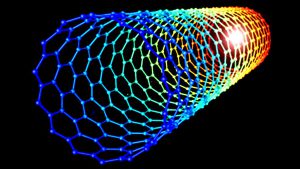NANOMATERIALS : a guide for the SUDOE space industry
Rescoll’Blog / 4 février 2015  This guide was prepared by the CarbonInspired 2.0 network and intends to make a summary review of nanoparticles and nanomaterials used in several industrial sectors, also showing the prototypes developed by CarbonInspired 2.0 consortium, providing example of practical applications, security issues and market.
This guide was prepared by the CarbonInspired 2.0 network and intends to make a summary review of nanoparticles and nanomaterials used in several industrial sectors, also showing the prototypes developed by CarbonInspired 2.0 consortium, providing example of practical applications, security issues and market.
The guide begins with the description of main concepts associated Nanotechnology, describing the different definitions of the nano-terminologies. Posteriorly, the guide will show the nanomaterials categorization for industrial applications, presenting the different categories of nanomaterials with industrial applications. Then, the chapter 4 will describe the different methods of production and manipulation of nanomaterials, especially the carbon-nanomaterials (carbon nanotubes, graphene). The chapter 5 will show an overview of the current nanotechnology application in the SUDOE space, based on the questionnaires results, describing the actual nanotechnology impact in the SUDOE space industry. The chapter 6 will present a review about the industrial applications of nanotechnology in industry. The Chapter 7 will describe the prototypes that are being developed for each partner of the CarbonInspired 2.0 consortium. Lastly, the guide will present the environmental impact and health issues concerning nanotechnology, describing the current major concerns regarding nanotechnology.
To download the guide index: Nanomaterials Guide
To receive a free copy of the full guide, please contact: commercial@rescoll.fr
Nanotechnology is the application of scientific knowledge to manipulate and control matter at the nanoscale in order to make use of size- and structure-dependent properties and phenomena, as distinct from those associated with individual atoms or molecules or with bulk materials. This field presents new opportunities for the development of everyday products with enhanced performance, reduced production cost and using less raw material. Fitting neatly with the European Union agenda for smart, sustainable and responsible growth, nanotechnology will potentially help address key societal challenges facing the region, such as the medical needs of an ageing population, more efficient use of resources, developing renewable energy to meet the enhanced commitments on energy efficiency, carbon emissions reduction and climate change.
Following the European Commission guidelines, nanotechnology has a key role transversal to several sectors. The semiconductor sector, for example, supports over 100 000 direct jobs in the region (and thousands more, indirectly). Europe must secure its role in other emerging nano-markets as well, taking the opportunity to develop profitable companies in new materials, processing equipment and device technologies. Europe’s pharmaceutical industry, for example, stands to benefit from the growth in the nanomedicine sector, particularly in cardiovascular treatments, anti-inflammatories, anti-infective, anticancer agents and central nervous system therapeutics. But while the region is at the forefront of research, it risks being usurped by the US, which is taking a lead in the number of patents, with a rapid progress in commercialization.
Nanotechnology also presents an opportunity to rejuvenate traditional industries, like chemicals and catalysts, papermaking and agriculture, bringing innovations in sustainability, processing, energy efficiency, recycling, emissions control and waste treatment. These sectors stand to be transformed, giving
Europe a clear margin of difference and added value over the global competition.
Solutions to the most major challenges facing Europe such as a secure affordable energy supply and reduced greenhouse gas emissions could also be provided by nanotechnologies and innovations in existing technologies. According to the International Energy Agency, big investment is needed to overhaul the world’s current energy system by 2050 and limit climate change to 2˚C. While this represents an enormous challenge, it also presents a technological opportunity: more efficient solar photovoltaics, wind turbines, energy conversion technologies, energy efficient insulating materials and carbon capture membranes, to name but a few will be required. In the next five to ten years alone, the low-carbon energy market including energy efficient technologies and alternative fuel vehicles, could be worth more than 1 billion euros. As well as the economic opportunity and the environmental imperative, the European Union (EU) also has a legal obligation, having pledged to a 20% reduction in emissions, increase in renewables and improvement in energy efficiency by 2020.
However, there are still question marks about the application of nanoparticles and nanomaterials, mainly because of the lack of information about their properties, applicability, but also due to concerns over possible adverse impacts of nanotechnology on the environment and health